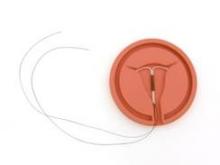CHICAGO – Uterine perforation rates are low for both the levonorgestrel intrauterine device and copper devices, and do not differ significantly between the two, according to the multinational EURAS-IUD study of more than 61,400 women.
Between 2006 and 2013, the rate of perforation among new users of levonorgestrel IUDs was 1.4/1,000 insertions and the rate for copper IUDs was 1.1/1,000 insertions, according to Dr. Klaas Heinemannn of ZEG-Berlin, who presented his prize-winning abstract at the annual meeting of the American Congress of Obstetricians and Gynecologists.
However, a striking difference was seen in the perforation rate among first-ever vs. repeat IUD users: 2.5/1,000 levonorgestrel IUDs and 1.4/1,000 for copper IUDs among first-time users, compared with 0.5/1,000 for both types among repeat users.
Of the 81 perforations, 64 were associated with known potential risk factors. For example, 35 women who experienced perforation were breastfeeding at the time of insertion, and 25 of those were breastfeeding at least six times daily. Seven women were treated with prostaglandin prior to insertion.
Breastfeeding was associated with a sixfold increase in risk of perforation with both the levonorgestrel and copper IUDs, Dr. Heinemann said.
None of the perforations in this study led to serious illness or injury to an internal organ, he noted.
Levonorgestrel IUD use was associated with a 10-fold decrease in the contraceptive failure rate, compared with copper IUDs. The rate of contraceptive failure did not differ significantly between the different types of copper IUDs used in the study. Similarly, the ectopic pregnancy rate was lower in the levonorgestrel IUD group, he noted.
The prospective, noninterventional EUSAR-IUD cohort study included 61,448 women from Germany, Austria, United Kingdom, Finland, Poland, and Sweden. The women completed follow-up questionnaires at 12 months after enrollment, and all patient-reported outcomes of interest were validated by the treating physician.
Most (about 70%) of the women used levonorgestrel IUDs, and about 30% used copper IUDs. Half were first-time users.
Only 2% of participants were lost to follow-up, with no significant difference between the two groups.
Differences between the groups remained significant after adjustment for a number of variables, including age, body mass index, time since last delivery, and breastfeeding.
The most striking difference in use was age. Women in their 20s and 30s used copper IUDs at more than twice the rate of levonorgestrel IUDs, while those aged 40 years and older used levonorgestrel IUDs at twice the rate of copper IUDs.
Although this study is limited by its observational nature, the results suggest that there is no clinically relevant increase in the risk of uterine perforation with either type of IUD, Dr. Heinemann said.
"However, we found a striking difference in the contraceptive failure rate," he said.
Based on the findings, the Safety Monitoring and Advisory Council that oversaw the study concluded that "the health benefits of IUDs outweigh the rare risk of perforation, including for women postpartum and those breastfeeding. No new restrictions in IUD use are warranted based on this study."
This study was supported by an unconditional grant from Bayer Healthcare, which markets Mirena (levonorgestrel-releasing intrauterine system). Dr. Heinemann reported having no disclosures.


